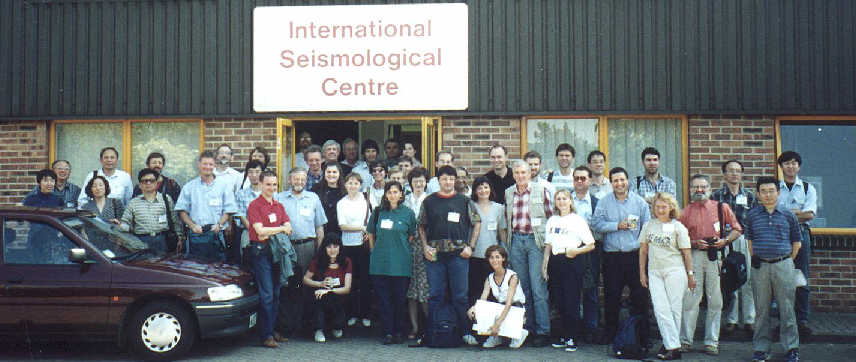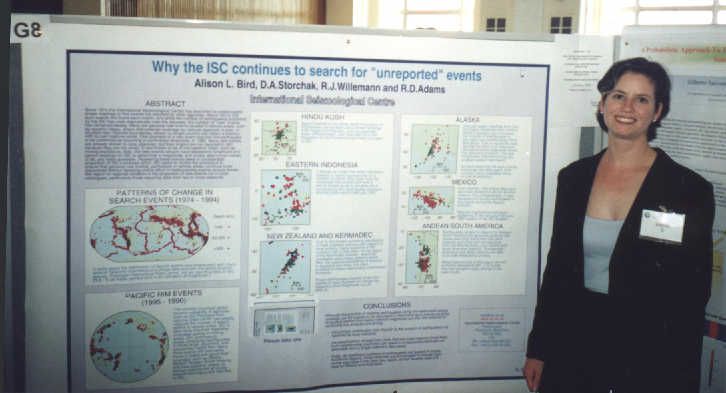

The ISC hosted an open house during IUGG99 that was attended by nearly 50 assembly delegates. Our visitors came from seismological institutions around the world, including Asia (Japan and China), South America (Brazil and Argentina), and North America (Canada and the US), and Australia as well as numerous "local" seismologists. The visitors attended brief presentations on ISC operations, but spent most of their time touring the building and chatting informally with the staff and each other. We even benefited from fine weather, and enjoyed an afternoon warm enough to help us all understand why the roads towards the beach were so crowded that morning!
The ISC's latest CD contains the complete Catalogue of 65 thousand events from 1964 through 1996, and the 1996 Bulletin data with 1.5 million phase arrivals. With PDF files of the typeset 1996 Bulletin as well, at £50 for personal copies it is a reference volume that many seismologists could afford to have on their shelf for quick reference.
Seismologists needing phase arrivals from a longer time period face a steeper cost, since they require five older CDs in addition to the latest. To meet their needs, the ISC now offers a set of CDs with all phase data for 1964 through 1995 for just £100. Orders for ISC CDs are available by downloading from http://www.gxjydl.com/doc/sales/cds_sales.html, or by sending e-mail to admin@isc.ac.uk
The ISC Governing Council held its bi-annual meeting at the University of Birmingham during the weekend before IUGG99. Among it most important actions, the Council decided that the ISC should experiment with hypocentres constrained by S and PKP arrival times, in addition to the P times used currently.
The smaller Executive Committee, meeting at greater length and more often, delves deeply into important issues. At this year's meeting, the Committee urged the Centre to publish its new database schema and accelerate development of an on-line system for editing the Bulletin.
Ray Willemann outlined the role of the ISC at the UN-sponsored forum marking the end of the International Decade for Natural Disaster Reduction in Geneva during July. The IDNDR programme has contributed to improvements in preparedness for natural disasters, including earthquakes, all around the world.
Many of the IDNDR seismological projects, such as GSHAP, make use of ISC data. Participation in forums such as this helps to raise awareness among policy makers of the importance of supporting the ongoing operations which in turn support special projects.

At IUGG99, an ISC poster describing how to obtain data from the ISC in print, on CDs, and on the Internet was well attended. ISC staff members also presented several analyses of the Bulletin in order to help users and to get feedback about what users are looking for from the ISC.
Noureddine Beghoul described part of his work to develop a new association algorithm. In order to optimise performance of the new algorithm, Noureddine has investigated reporting patterns of different stations. Some stations report only local or regional phases to the ISC; for those stations association with nearby earthquakes should be strongly preferred over teleseismic association.
Alison Bird presented an overview of "search", i.e., events formed from unassociated readings. Alison found that the geographic distribution has changed from the early 1990', when many search events where located in mid-ocean regions, some with magnitudes greater than 5. Instead, most search events now are in relatively well monitored regions, where the events may already be known to agencies that do not report comprehensively to the ISC. In the future, ISC data collection or processing could be modified to reduce effort devoted to this task while continuing to watch out for occasional remote events that still are missed by other global agencies.
Dmitry Storchak compared the ISC Bulletin with the prototype IDC's 1996 Reviewed Event Bulletin (REB). He found that among events with just 3 or 4 stations in the REB, one of the stations was occasionally misassociated, and the remaining stations might not constrain the location very well. With many more stations reporting, the ISC is able to determine that when no event occurred near such REB locations. Examples are most common in areas where local networks are most dense, such as Japan. It seems likely that misassociations occur elsewhere, especially where the monitoring network is sparse, but even the ISC lacks sufficient data to discover them.
Ray Willemann outlined ideas on how the Bulletin should change to support seismologists in the future. Change is driven partly by requirements for more accurate locations that can now be computed from regional velocity models. More fundamentally, however, high-gain, broadband digital seismic records include a greater range of information than the traditional picks of onset time, polarity and amplitude can capture. In the twenty-first century seismologists will have uses for a bulletin with a different, wider set of waveform measurements and earthquake parameters, and the ISC plans to provide it as quickly and as comprehensively as possible.
Despite the growing prevalence of e-mail and other computer-readable seismic bulletins, the ISC still requires a data entry from about a dozen bulletins each month, as well as keying of editing decisions by ISC seismologists. Carol Tubby has filled that role for the past 11 years, and developed a range of expertise that lets her bring changes in reporting patterns to the attention of ISC seismologists. Unfortunately for the ISC, Carol's personal affairs are taking her far from Thatcham, and a fresh recruit is required.
Cliff Allen joined the ISC in September and, based on just a few weeks of working with Carol, has quickly come up to speed. Cliff is an amateur astronomer who brings a keen interest in science to the job. Apart from his previous data entry experience, Cliff is familiar with Internet applications. He is looking forward to becoming involved in electronic data collection when the introduction of on-line editing begins to reduce the need for data entry.
Most seismologists know of the International Data Centre (IDC) being established in Vienna, Austria for monitoring the Comprehensive Test Ban Treaty. With waveform data received continuously from a global network, the IDC offers a glimpse of how practice might develop elsewhere. In September, Director Ray Willemann visited Vienna to discuss how the IDC and ISC might be able to work together.
One important topic was data exchange formats. A new format developed to exchange treaty monitoring data is likely to be widely used, but modifications would benefit many seismologists by accommodating data types that are important for studies of seismotectonics, seismic hazard, and earthquake physics.
In addition, Ray talked with IDC staff about ISC's regular evaluation of other bulletins by comparison with the ISC Bulletin and how ISC data and services might contribute to improvements in IDC operations. Work between the two centres will concentrate on data exchange formats for now, but might expand into evaluation of earth models, including travel times and attenuation.
国产精品无码免费专区午夜_精品无码国产一区二区三区51安_AV无码久久久久不卡蜜桃_在线观看片免费人成视频无码